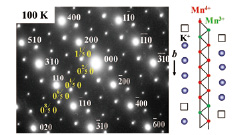Mn3+/Mn4+ Charge Order Driven by K-Vacancy Order in Mn-Hollandite
Y. Ueda Group
Hollandite type oxides, K2M8O16 with a mixed valence of M3+/M4+ =1/3 have intensively investigated, expecting novel itinerant properties such as metal-insulator (MI) transition, charge order and so on. Actually, K2V8O16 was found to undergo the metal-insulator transition at 170K, accompanied by the structural transition and charge order [1, 2]. A very rare ferromagnetic MI transition was discovered in K2Cr8O16 [3]. This MI transition is caused by a Peierls instability in the quasi-one-dimensional column structure made of four coupled Cr-O chains running in the c-direction, leading to the formation of tetramers of Cr ions below the transition temperature [4].

Fig. 1. Electron diffraction pattern observed at 100 K and schematic illustration of charge order between Mn4+ and Mn3+ for K1.6Mn8O16. The electron beam incidence is along the [001] direction of the monoclinic lattice. The superlattice reflections with five-fold periodicity along the b-axis (tunnel direction) are clearly observed, indicating K-vacancies ordering. The extra electrons are trapped by Mn ions adjacent to K-vacancies, leading to charge order between Mn4+ and Mn3+.
The crystal structure consists of the M8O16-framework and K-cations. The M8O16-framework is constructed from the double-chains (zigzag-chains) formed by sharing the edges of MO6 octahedra. The M8O16-framework has rectangular tubes surrounded by four double-chains, and K-cations occupy the sites within each rectangular tube and act as electron donor.
KxMn8O16 was prepared by high-pressure synthesis using a cubic anvil press [5]. Unfortunately Mn-hollandite was obtained only in K-deficient form. The maximum K-composition is x=1.6, in which K-vacancy molar fraction is 1/5 and Mn3+ molar fraction is also the same 1/5. K1.6Mn8O16 is not a metal and a canted antiferromagnet with Néel temperature of 50 K. Resistivity well obeys a one-dimensional variable range hopping manner. K1.6Mn8O16 shows successive structural transitions of tetragonal to monoclinic at 370 K and monoclinic to monoclinic at 250 K. The superlattice reflections with five-fold periodicity along the b-axis (tunnel direction) as shown in Fig. 1, are observed by electron diffraction of TEM (transmission electron microscope) below 250 K. Such a five-fold periodicity is consistent with the fraction of K-vacancies, 0.4/2=1/5, suggesting vacancy-ordering at 250 K. At room temperature, similar but rather diffusive super-reflections are observed. These results suggest that in K1.6Mn8O16, the charge differentiation into Mn3+ and Mn4+ occurs even at higher temperature than at least 370 K and a short range order of K-vacancies progresses below 370 K, followed by a sudden long range order at 250 K. Such charge differentiation in K1.6Mn8O16 could be due to K-deficiency, because the fraction of Mn3+ is 1/5 which coincides with the fraction of K-vacancies. Namely, extra eg-electrons are trapped at Mn ions close to K-vacancies, giving rise to Mn3+ ions, namely an ordering between Mn3+ and Mn4+ takes place in cooperation with K-vacancy ordering. An origin for K-deficiency in hollandite manganese oxide could be in its rather shorter b-axis compared with those of K2M8O16 (M = Ti, V, Cr). The electrostatic repulsion between K+ ions in the tunnel would not allow the full occupancy of K-sites. Much higher pressure would be necessary for the synthesis of the stoichiometric K2Mn8O16.
References
- [1] M. Isobe, S. Koishi, N. Kouno, J. Yamaura, T. Yamauchi, H. Ueda, H. Gotou, T. Yagi, and Y. Ueda, J. Phys. Soc. Jpn. 75, 073801 (2006).
- [2] A. C. Komarek, M. Isobe, J. Hemberger, D. Meier, T. Lorenz, D. Trots, A. Cervellino, M. T. Fernández-Díaz, Y. Ueda, and M. Braden, Phys. Rev. Lett. 107, 027201 (2011).
- [3] K. Hasegawa, M. Isobe, T. Yamauchi, H. Ueda, J-I. Yamaura, H. Gotou, T. Yagi, H. Sato, and Y. Ueda, Phys. Rev. Lett. 103, 146403 (2009).
- [4] T. Toriyama. A. Nakao, H. Nakao, Y. Murakami, K. Hasegawa, M. Isobe, Y. Ueda, A. V. Ushakov, D. I. Khomskii, S. V. Streltsov, T. Konishi, and Y. Ohta, Phys. Rev. Lett. 107, 266402 (2011).
- [5] T. Kuwabara, M. Iosbe, H. Gotoh, T. Yagi, D. Nishio-Hamane, and Y. Ueda, J. Phys. Soc. Jpn. 81, 104701 (2012).
